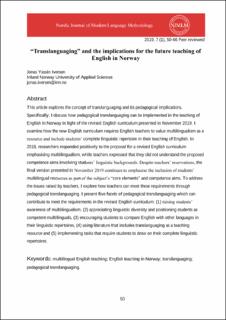| dc.contributor.author | Iversen, Jonas Yassin | |
| dc.date.accessioned | 2023-08-02T11:57:23Z | |
| dc.date.available | 2023-08-02T11:57:23Z | |
| dc.date.created | 2020-01-21T12:53:50Z | |
| dc.date.issued | 2019 | |
| dc.identifier.citation | Nordic Journal of Modern Language Methodology. 2019, 7 (1), 50-66. | en_US |
| dc.identifier.issn | 1894-2245 | |
| dc.identifier.uri | https://hdl.handle.net/11250/3082328 | |
| dc.description | Article published in Nordic Journal of Modern Language Methodology under the licence Attribution 3.0 Unported (CC BY 3.0) | en_US |
| dc.description.abstract | This article explores the concept of translanguaging and its pedagogical implications. Specifically, I discuss how pedagogical translanguaging can be implemented in the teaching of English in Norway in light of the revised English curriculum presented in November 2019. I examine how the new English curriculum requires English teachers to value multilingualism as a resource and include students’ complete linguistic repertoire in their teaching of English. In 2018, researchers responded positively to the proposal for a revised English curriculum emphasising multilingualism, while teachers expressed that they did not understand the proposed competence aims involving students’ linguistic backgrounds. Despite teachers’ reservations, the final version presented in November 2019 continues to emphasise the inclusion of students’ multilingual resources as part of the subject’s “core elements” and competence aims. To address the issues raised by teachers, I explore how teachers can meet these requirements through pedagogical translanguaging. I present five facets of pedagogical translanguaging which can contribute to meet the requirements in the revised English curriculum: (1) raising students’ awareness of multilingualism, (2) appreciating linguistic diversity and positioning students as competent multilinguals, (3) encouraging students to compare English with other languages in their linguistic repertoires, (4) using literature that includes translanguaging as a teaching resource and (5) implementing tasks that require students to draw on their complete linguistic repertoires. | en_US |
| dc.language.iso | eng | en_US |
| dc.relation.uri | https://journal.uia.no/index.php/NJMLM/article/view/520#.Xi6QBTJKipo | |
| dc.title | “Translanguaging” and the implications for the future teaching of English in Norway | en_US |
| dc.type | Peer reviewed | en_US |
| dc.type | Journal article | en_US |
| dc.description.version | publishedVersion | en_US |
| dc.rights.holder | Authors retain copyright and grant the journal right of first publication with the work simultaneously licensed under a Creative Commons Attribution License that allows others to share the work with an acknowledgement of the work's authorship and initial publication in this journal. | en_US |
| dc.source.pagenumber | 50-66 | en_US |
| dc.source.volume | 7 | en_US |
| dc.source.journal | Nordic Journal of Modern Language Methodology | en_US |
| dc.source.issue | 1 | en_US |
| dc.identifier.cristin | 1779157 | |
| cristin.ispublished | true | |
| cristin.fulltext | original | |
| cristin.qualitycode | 1 | |
